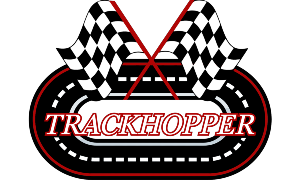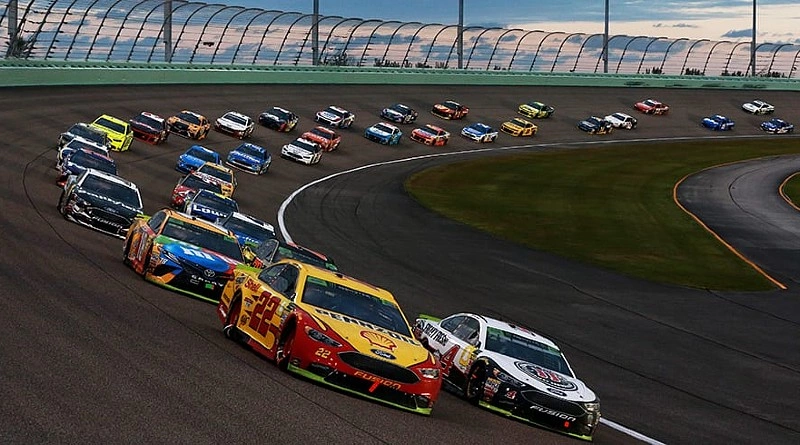If you are new to motorsports, you’ve probably noticed that it’s difficult to grasp what the commentators are saying during a race, primarily due to the vast amount of sport-specific terminology that gets used. It might even sound like another language and affect your interest, causing you to change the channel and shy away from the sport. Even more difficult is that not all racing lingo is the same. The vocabulary used in NASCAR is quite different from Formula One racing, and IndyCar is almost a combination of the two.
So, let’s start with some simple explanations of the most popular NASCAR terminology, specific to the Xfinity Series and Cup Series.
TERMS
AERO – The science of aerodynamics. How air flows around the movement of the car, causing differences in speed.
APRON – The flat portion at the bottom of the racetrack.
APEX – The geometric center of a turn. Striving to hit the apex enables the driver to take the turn in the straightest line possible, therefore maintaining the highest speed possible.
ALL-STAR RACE – A non-points paying race with a specific set of rules unlike the rest of the season, and only drivers that are former winners may enter.
BACK MARKER – A slower car that usually runs at the back of the pack.
BACKSTRETCH / FRONT STRETCH – The long straightaway portion of the oval, located at the back or the front of the track.
BALLAST – The Tungsten metal weight inserted into the car to balance the weight of the front and rear.
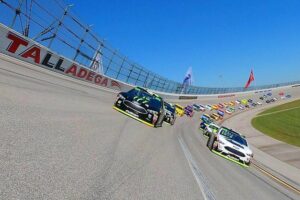
BANKING / BANKED TURN – The slope of the track. A turn that is inclined so that the outside area is higher than the inside area, therefore producing higher speeds.
BIG ONE – Refers to a severe multi-car wreck, typically seen at superspeedways.
BINDERS – Brakes
BITE – Traction at the rear wheels of the car.
BLISTER – A bubble that forms on a tire due to extreme heat.
BLOCKING – Refers to a car changing positions on the track to prevent other drivers from passing.
BLUE OVAL – The blue symbol belonging to the FORD manufacturer.
BOBBLE – a miscue by a driver
BOW TIE – The cross-like symbol of the Chevrolet manufacturer.
BRICKYARD – Nickname given to Indianapolis Speedway due to its history of bricks as pavement. To this day, a small section of bricks remains at the Start/Finish line.
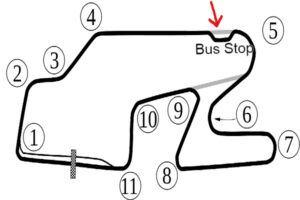
BUS STOP / CAROUSEL / CHICANE / INNER LOOP – Part of the track on a road course, and clearly it comes with several nicknames. A tight sequence of corners in alternate directions used to slow the speed of the cars.
CAMBER – The angle that wheels are tilted inward or outward. A wheel tilted inward toward the top is referred to as negative camber.
CATCH FENCE – A long stretch of chain link fence mounted atop the track wall, particularly in front of the grandstands, to prevent cars or pieces of cars from flying into the crowd in the event of a wreck.
CAR CHIEF / CREW CHIEF – The Car Chief oversees the building and mechanics of the car. The Crew Chief is responsible for the efficiency of the entire team including mechanics, engineers, and pit crew. Crew Chiefs are also responsible for race strategy and sit atop the pit box overseeing the pit crew during the race.
CHAMPIONSHIP (Driver, Team, Manufacturer) – The title awarded to the winning driver, team, or manufacturer at the end of each season.
CHECK-UP / CHECK OUT – Checking up refers to sudden braking. Check out or checking out refers to the lead car pulling away from the rest of the cars.
CIRCUIT – It can refer to a single track, or it can refer to all tracks on the schedule for the racing season.
CLEAN AIR – Air without turbulence produced from other race cars. Clean air can be found at the very front of the field.
COCKPIT – The area in which the driver sits in the car.

COMMITMENT CONE – The orange cone located at the entrance of pit road. Drivers must commit to their decision to enter pit road by remaining below the cone. If they veer back onto the track past the cone it results in a penalty, mainly due to safety issues.
COMPETITION CAUTION – A scheduled caution flag introduced into the early portion of the race that allows teams to check tire wear. This is usually due to inclement weather that has washed the track clean the night before a race, or due to lack of scheduled practice before the race.
COMPOSITE BODY – Body parts are bolted instead of welded together, creating a somewhat flexible body that more easily sustains minor accidents.
CONTROL CAR – The lead car is designated as the control car, and has preference over the inside or outside lane to start or restart the race. This is also the car that determines when drivers will accelerate coming to the start line.
CURB – Used at races that involve road courses instead of oval tracks. They are raised sections of asphalt or cement usually located on the inside and/or outside of a turn. They are typically painted yellow to assist drivers in locating the apex of the turn.
CORNERS – Slang for turns
DARLINGTON STRIPE – This specifically refers to Darlington Raceway, when a car brushes or slams the wall and is left with a red paint streak on the right-hand side of the car.
DIALED IN – An adjustment made to the car that makes it easier to drive and therefore faster.
DIRTY AIR – Turbulence created by airflow coming off all cars.
DNF / DNS – Did Not Finish. Did Not Start
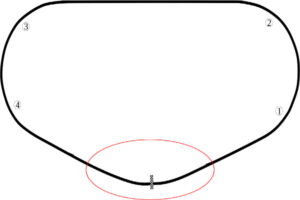
DOG LEG – Slight bend in the track resembling the crook of a dog’s back leg, usually located on the front stretch, but not classified as a turn.
DOWNFORCE – The downward force created by airflow around the car necessary for high speeds in turns.
DRAFTING / SIDE DRAFTING – Drafting is the aerodynamic science that enables 2 or more cars running nose-to-tail to be faster than one single car. The lead car cuts through the air so the car/cars ‘directly’ behind experience less resistance. Side drafting is the act of pulling closely alongside a competitor’s rear quarter panel to dump turbulent air onto the other car’s back end (deck lid and spoiler), therefore reducing the other car’s speed.
DRAG – This refers to wind resistance or anything that negatively affects the aerodynamics of the car, resulting in lesser speed and handling.
DRAG RACE – Two cars coming to the finish line, evenly matched side by side and therefore resembling a drag race. Side drafting is involved (see side drafting) and often the cars will door slam each other while attempting to slow each other down.
FENCE – Slang for the wall around the track.
FIELD – The collective group of cars in the race.

FLAGMAN – The flagman is located on a raised platform over the start/finish line, with the job of displaying colored flags that each hold their own meaning and instructions for the race.
FLAT SPOT – When a car slides and the driver locks up the brakes, the area of the tire scraping the pavement is exposed to excessive wear that creates flat spots. This leads to vibrations and other problems and requires a pit stop for fresh tires.
FRESH RUBBER – New tires.
GRID / STARTING GRID – The starting order of the cars.
GRIP / TRACTION: The amount of traction a car has at any given point, affecting how easy it is for the driver to keep control through corners.
GREEN-WHITE-CHECKERED – This is the result of a late-race caution when the combination of pit stops and pace laps leaves only 2 laps of the race remaining. The green flag restarts the race, the following lap produces the white flag to signify only 1 lap to go, and the checkered flag finishes the final lap. (see overtime)
GROOVE – The ‘line’ that offers the fastest way around the track. The groove often changes during a race due to temperature or the amount of rubber accumulating on the pavement. Usually, the accepted groove moves up the track as the race progresses. Oftentimes, more than one groove will develop.
HANS DEVICE – HANS is an acronym for ‘Head and Neck Support’. It is a mandatory safety device that straps to the back of the driver’s helmet and acts as a head and neck restraint.
HIGH LINE – The line or groove (See Groove) at the uppermost portion of the track next to the wall.
INTERMEDIATE TRACK – A track that measures greater than 1 mile in length and is the most common type of track visited during the NASCAR season.
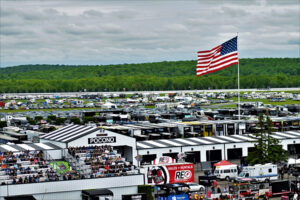
INFIELD – The inner area of the racetrack that typically houses the car garages, team haulers and motorhomes, a media center, a medical facility, and sometimes camping facilities for fans.
JUMP THE START – When the lead car accelerates before the restart zone, or when the second-place car accelerates before the leader.
LAP / LAPPED CAR / LAPPERS – A lap is a full and complete trip around the racetrack. A lapped car, or sometimes called lappers, are cars that are falling behind in laps, due to factors such as slower speeds, time spent in the pit for repairs, or having to serve a penalty. Lapped cars create ‘traffic’ for cars on the lead lap.
LIFT – To let up on the gas/throttle.
LINE – See Groove
LOCK-UP / WHEEL HOP – Refers to a driver over-braking quickly thus locking up one or more tires, often causing the tires to bounce/hop over the track.
LOOSE / TIGHT – Loose refers to the car’s handling and is known as oversteer. It also refers to the rear wheels having difficulty sticking to the track in the turns. Tight is obviously the complete opposite. The car is not turning well and traction in the front is poor.
MARBLES – Small bits of rubber, dirt, and traction compound that form during the race and collect near the outside wall of the track. If a car gets into the marbles, it impedes traction.
MOCK RUN – The act of mimicking a race run during practice.
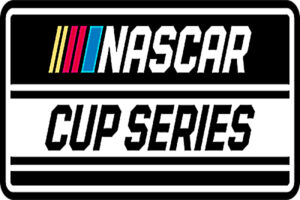
NASCAR – National Association of Stock Car Auto Racing.
OVAL – The typical shape of most racetracks.
P1/P2/P3 etc – Refers to a car’s position on the track, for example – Position 1 (leader), Position 2 (second place car), etc.
PACE CAR – The car that leads the field at the start of a race and again during caution flags. The pace car limits the speed at which the cars can drive until the track is clear, then the pace car leaves the track so the field can resume racing.
PINCH – When a race car pushes toward another car, forcing that car toward the outside wall or toward the apron to keep the car from advancing. The desired outcome is that it will cause the car to slow down and fall in line behind the aggressive car. However, if done incorrectly, or if the driver receiving the pinch gets aggressive and pushes back, it can result in a wreck.
PIT – The space designated for a team to set up a service area for their car, allowing the driver to come in for gas, fresh tires, and any potential repairs.
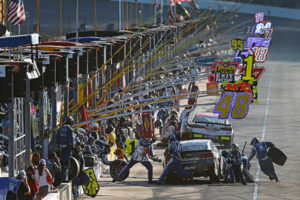
PIT ROAD – A small roadway with access from the track, on which every team has a designated space called a “pit box”.
POLE POSITION – The car/driver with the fastest speed during qualifying is awarded pole position and their choice of pit stall. Typically the team will choose the 1st pit stall to allow easy access back on to the track. This awards the driver/car with the 1st position on the starting grid.
QUALIFYING – An event held prior to the race in which every race team is allowed one lap on the track to achieve their fastest speed. The starting grid is set based on those speeds, setting the cars in rows of two, from fastest to slowest.
RACE TRIM / QUALIFYING TRIM – Terms used to describe how a car is set up for qualifying. If the car is set up in race trim, it means the team is focused on the race itself and has set up the car for the long haul. Conversely, if the team is focused on obtaining the fastest speed possible to start the race at the front of the grid, the car will be set up in qualifying trim. This means more downforce, and typically the grill will be taped up as much as possible to improve aerodynamics.
RESTART ZONE – The designated space before the Start/Finish line that determines the area in which the leader is allowed to accelerate during the start or restart of a race.
RESTRICTOR PLATE / PLATE RACE – A restrictor plate is a device installed in the engine to limit horsepower/speed exclusively at superspeedways (Daytona and Talladega). They are used as a safety measure because these tracks produce excessive speeds. Restrictor plates result in the cars running more closely together, in a ‘pack’ instead of single file, and the events have become known as ‘plate’ races. (See Tapered Spacer)
ROAD COURSE – Contrary to popular belief, not all NASCAR races take place on oval tracks. Several times during the season races take place on road courses, which feature various bends, S curves, and chicanes, requiring both left and right turns. These tracks include Sonoma, Watkins Glen, Circuit of The Americas, Road America, Daytona Road Course, and the Charlotte Roval.
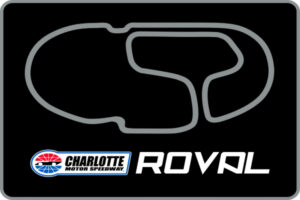 ROVAL – The race known as The Roval was introduced in 2018 and is located at Charlotte Motor Speedway. However, instead of using the entirety of the oval track, this race incorporates half the oval and half the road course which is located on the infield.
ROVAL – The race known as The Roval was introduced in 2018 and is located at Charlotte Motor Speedway. However, instead of using the entirety of the oval track, this race incorporates half the oval and half the road course which is located on the infield.
ROTATE – Rotating a car is the act of getting the best trajectory at the middle point of a turn in order to get the best drive off at the exit, with minimal loss of speed.
RUBBER UP – The accumulation of tire residue (rubber) that gets laid down on the track during the race.
SAFER BARRIER – SAFER is an acronym for ‘Steel and Foam Energy Reduction’. It is a barrier (wall) around the track designed to absorb and reduce the impact of a high-speed crash. Therefore, it lessens driver injuries.
SHOOTOUT – See Green-White-Checkered
SHORT PIT – Race strategy that involves pitting to refuel and get fresh tires before it is necessary, ideally to take over the lead when the remaining cars need to pit.
SHORT TRACK RACING – Racing that takes place on tracks shorter than a mile long. The cars are set up differently, the speeds are slower, and the race is characteristically more aggressive due to more contact between cars.
SLIDEJOB – A term that originated with dirt track racing and describes a passing technique. The car drives into the turn low on the track while carrying excessive speed so the car will automatically drift up the track and cut off the competitor in the high line. (see High Line)
SLINGSHOT – When a driver pulls out of the draft and shoots past the cars on the low line using the power in reserve from being in the draft.
SPLITTER – Found on the front edge of the car and used for aerodynamic purposes. It runs the full width of the car and often looks low enough to scrape the track surface.
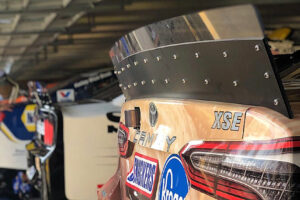
SPOILER – The plexiglass blade attached to the rear of the car to reduce airflow and provide stabilization (see Downforce) The height of the spoiler varies with the type of track and race regulations.
STAGE / STAGE RACING – In 2017, NASCAR changed its points system by breaking races into 3 parts and awarding points to the top 10 cars in Stages 1 and 2. The third and final stage depicts the race winner. The change was made to encourage competition throughout the entirety of the race, instead of allowing drivers to wait until the very end of the race to make their moves.
STICKER TIRES / SCUFFS – ‘Stickers’ refers to brand new tires. Scuffs are gently used tires that are reapplied to a car if the team runs out of new tires.
STRAIGHTAWAY – See Backstretch/Frontstretch
STOP AND GO PENALTY – Refers to a car being called to pit road and forced to come to a complete stop in their pit box before being allowed to resume the race. This is a penalty for a rules infraction by the driver.
SUPER SPEEDWAY – A track with severe banking and measuring more than 2 miles long.
TAPERED SPACER – Used at some superspeedways and essentially the same thing as a restrictor plate. However, tapered spacers have larger openings to allow for more airflow than a restrictor plate and they do not reduce the horsepower quite as much. However, due to tradition, these events continue to be called ‘plate’ races. (see Restrictor Plate)

TEAMMATE(S) – Drivers that race for the same team/organization. NASCAR rules state that a team is limited to no more than 4 cars.
THE CHASE / THE PLAYOFFS – The final 10 races of the season in which only the top 16 drivers in the points standings are eligible to race for the championship. It works on a bracketed elimination system where 4 drivers with the least points are eliminated after every 3 races. The final race pits the final 4 drivers against each other and crowns a champion. This process was originally called ‘The Chase’ and still is by many people, particularly traditionalists. However, in 2017 NASCAR adopted the term ‘Playoffs’ to align with many other sports.
The W – The win
THROTTLE – Gas pedal
TOWER – The control tower manned by NASCAR officials who dispense commands, flag instructions, and penalties.
TRACTION COMPOUND / PJ1 / VHT – A sticky substance spread on designated portions of the track to increase traction, typically seen at single groove racetracks with the intention of creating multi-grooves for competition. The chemical compound has earned several different nicknames, including ‘sticky stuff’ and ‘awesome sauce’.
WAVE AROUND / LUCKY DOG – The Wave Around refers to lapped cars that choose not to pit during a yellow flag pit cycle and are given permission to pass the pace car in order to make up ONE lap. The Lucky Dog is the first car that is a lap down and can take the wave around plus are allowed to pit.
WEDGE ADJUSTMENT / ROUND OF WEDGE – A wedge adjustment increases or reduces the amount of tension on a spring in the rear suspension and therefore alters the way the car handles. These adjustments are made to rectify loose and tight cars.
EXPRESSIONS
DROP THE HAMMER – Expression used to describe when a driver accelerates.
BEING/GETTING PARKED – Disobeying NASCAR’s rules and warnings can lead to a car getting ‘parked’ for the remainder of a race or longer, meaning they cannot compete on the track.
GET INTO THE FENCE – The word ‘fence’ is interchangeable with ‘wall’, so this describes a car that has slammed the outside wall.
GET UP ON THE WHEEL – Slang for when a driver becomes so determined that they symbolically sit forward and lean in.
GETTING TURNED – When a driver pushes another car on the corner of the bumper, creating a disturbance in the car’s ability to drive straight. Instead, the car will automatically start to spin.
GETTING JACKED UP – When a car pushes the car ahead of it in an attempt to give him speed but instead pushes too hard causing the nose of his car to wedge under the back bumper of the car he is pushing. This literally jacks the car up so the rear wheels are unable to gain traction.
HOLD THE LINE – To be committed to a certain groove on the track.
JUMP THE CUSHION – An expression mainly used at short tracks when a driver steps over the line between a safe and unsafe distance from the wall.
ON THE SPLITTER – When the downforce of a car is unbalanced between the front and rear, putting excess force on the nose of the car, and making it feel as though the splitter is digging into the track. (see Splitter)
RACE THE TRACK – When track conditions are constantly changing, forcing teams to predict what the car will need in order to sustain speed and handling.
RUNNING THE WALL / RIDING THE WALL – Running the wall refers to driving as close to it as possible to increase aerodynamics and speed. Riding the wall means getting too far into it and, due to aerodynamics, being pinned to it while scraping up against it.
SLICING AND DICING – Essentially a fast car hoping to get to the front by breaking up cars in the draft and therefore slowing them down. This is done by side drafting a car and then pulling into the gap between that car and the one ahead of it. Then, pulling out of line to side-draft the next car and pulling in between once again, ultimately slicing the cars apart.
TIRE FALL OFF – The tires are not literally falling off the car. It’s an expression used to describe tires losing grip because they are getting old and need replacing.
TRACK COMING TO YOU – When the car is set up for eventual track conditions. For example, a race might start under cloud cover but be in direct sunlight and getting hot by the final stage. If the car was set up for hot conditions, the driver refers to the track as coming to him because it is now cooperating with the car’s set up, therefore handling better.
WRECKING LOOSE – Describes the car feeling so very loose due to understeer that the driver feels they could wreck at any moment.
FLAG MEANINGS
GREEN FLAG – Just like a stoplight, green means go.
YELLOW FLAG – Denotes a caution, something drivers need to be cautious of, such as debris on the track or a wreck. Cars slow down and the pace car is deployed until the on-track problem is rectified and the race can return to green.
RED FLAG – Denotes a big on-track problem, such as a multi-car wreck, that can only be addressed if all cars are stopped and kept out of the way. If the red flag is displayed due to rain, all cars are brought down pit road and stopped.
BLUE FLAG – In NASCAR, the blue flag contains a diagonal yellow stripe and is used to instruct slow cars to move out of the way of oncoming traffic that is moving at a much faster pace.
BLACK FLAG – The black flag is car/driver-specific, indicating that a driver has done something wrong and needs to return to pit road, or the car itself is not fit to be on track. Ignoring the black flag will result in laps no longer counting or being parked. (see Getting Parked in the Expressions section)
GREEN AND WHITE CHECKERED – The green and white checkered flag is not to be confused with the Green-White-Checkered sequence which was explained in the Terms section. This flag is waved at the end of a stage for the first 10 lead cars that cross the finish line. These cars are awarded points relative to their position. Example, 1st place = 10 points, 2nd place = 9 points, 3rd place = 8 points etc.
WHITE FLAG – Signifies one lap to go before the end of the race.
CHECKERED FLAG – Signifies the end of the race. As cars pass the finish line, they are scored as to their position.
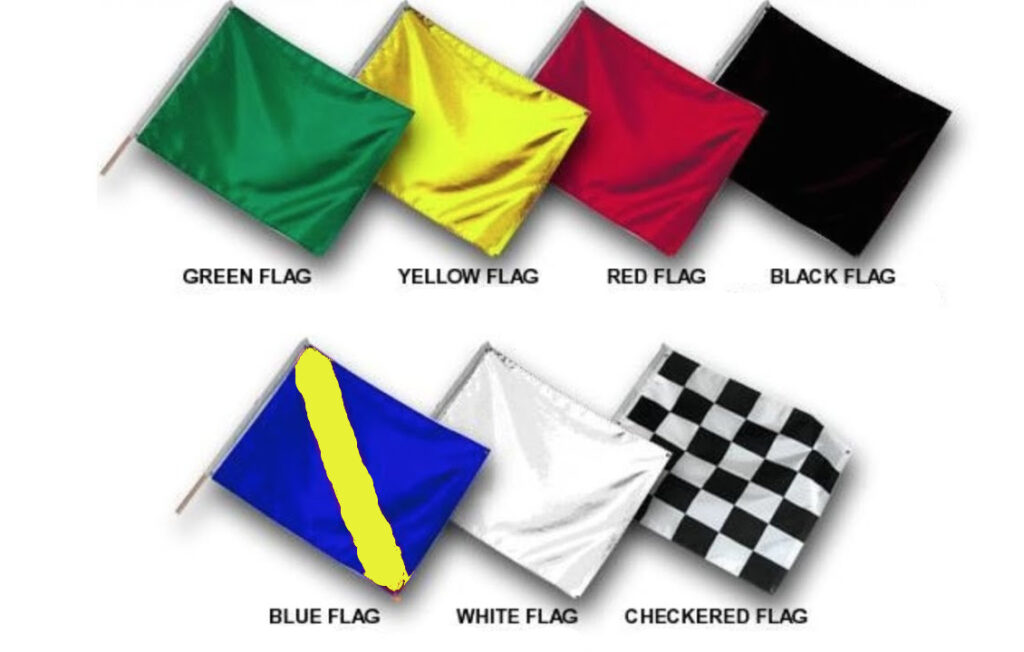
Still have questions? Tweet at us using #AskTrackHopper
